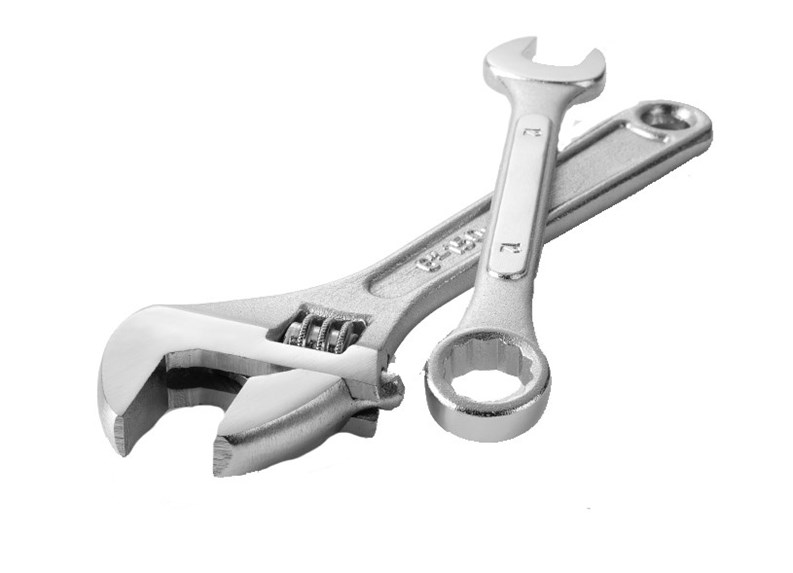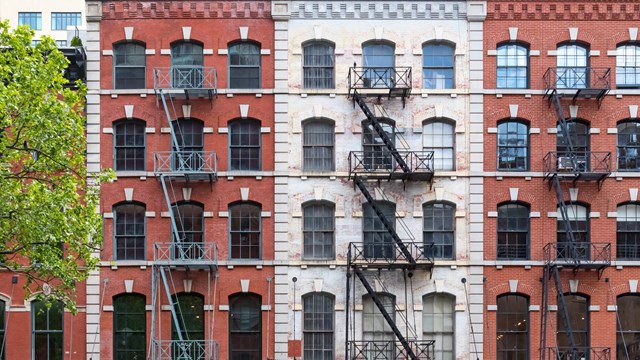Recently many northern tier cities have enacted building façade inspection laws to ensure public safety. One of the primary reasons for these laws has been aging and deterioration of the ornamental on older buildings, which is made from architectural terra cotta. When architectural terra cotta is maintained properly, it is a safe and beautiful material which gives older buildings their character.
What Is Terra Cotta?
Architectural terra cotta was primarily used in this country from the late 1800's until the 1930's. It is a man-made material used to imitate carved stone. Terra cotta is cast from molds and baked in an oven. Finally a glaze is applied and the material is baked again, just like a dish or a coffee mug. The shapes that terra cotta can be cast into range from simple square blocks to ornate statues. Because the final color comes from an applied glaze, there is no real limit to the color possibilities, but usually we find architectural terra cotta in beige and sometimes red ochre colors.
Terra cotta units are hollow, much like a concrete block. They are also a weak material and therefore, can only be used in an ornamental fashion. It can not be used to support the weight of the masonry wall above it. In most buildings there is a supporting framework made from steel that supports the terra cotta, especially at projections like cornices and ornamental balconies.
Terra cotta was used because it was less expensive than stone and the architectural terra cotta could be mass-produced to further reduce its cost. It was also easy to create custom designed pieces because of the ease of molding and fabrication of terra cotta units. Architectural terra cotta is also a lighter weight material than stone, which makes it easier to install and support than stone work.
Why It Fails
Typically, terra cotta fails due to the rusting of the steel framing which supports the terra cotta. The rusting causes the steel to expand and as it expands, it cracks and breaks the terra cotta. Other causes of failure include: mechanical damage from scaffolding; deterioration of the glaze, which allows for moisture penetration and freeze thaw damage; and overloading of the terra cotta, which causes it to crack and break.
The danger from failed terra cotta occurs typically when the terra cotta units project out from the building wall to form a cornice, decorative band, decorative balconies or projecting sills. When these units fail, pieces break off and fall to the street, creating a danger for pedestrians. Embedded terra cotta units can have pieces that fall off too, but it is rare. Embedded pieces are usually found at building corners, and have the appearance of large stones set into the wall.
The first step is to conduct a visual examination of the terra cotta units, looking for cracks, displacement and broken pieces. It must be noted that a failure due to freeze and thaw conditions and/or rusting may not be visible, even from an up-close examination.
In order to fully determine the condition of the terra cotta, it must be examined by sounding on a regular basis. Typically a representative area is sounded for these purposes. However, if a terra cotta restoration project is being conducted, then all the terra cotta should be sounded as part of the restoration process. A lightweight hammer is used, preferably a wooden mallet. Terra cotta units are gently tapped with the hammer, and the tester listens carefully to the sound made by the tapping. A trained professional will be able to tell the difference between a fit piece of terra cotta and an "unsound" piece.
Patch or Replace
Depending upon the nature of the deterioration found and the location of the units, two remediation options may be considered: repair and patching or complete replacement of the terra cotta unit. The repair is usually made by installing stainless steel dowels into and through the terra cotta unit into the masonry back-up of the wall system. Cracks are routed out and sealed and the glaze is repaired. The patching is made with special patching mortars formulated to be compatible with the existing terra cotta. The patching mortars can be sculpted by an artisan to create the most intricate details. If the terra cotta unit is too deteriorated to repair, or if there is an underlying condition causing the deterioration of the terra cotta, then it will usually have to be removed and replaced.
Full replacement of the deteriorated terra cotta unit requires that molds be made of the existing terra cotta. In addition to the molds, shop drawings, color samples and finish samples are prepared for approval prior to the fabrication of replacement units. Historic quality and budget constraints are two major criteria for selection of the material used to fabricate the replacement pieces. Replacement units may be fabricated out of terra cotta, cast stone or glass fiber reinforced concrete (GFRC). Terra cotta replacement units typically provide the best overall match but are usually the most expensive. Cast stone units can provide a very good match, especially for units with limited color ranges. GFRC is lighter weight material, which can also provide a good match, but because of its thermal expansion and contraction properties differ from those of terra cotta and masonry, it can be used only in select areas isolated from the surrounding masonry with expansion joints. The replacement units are then installed, usually with new steelwork.
A good terra cotta restoration project will enhance the safety value and aesthetics of a building. Use an experienced professional to investigate and prepare a scope of work to remediate terra cotta deficiencies.
Mr. Secon, R.A. is a senior project manager with Inspection & Valuation, Inc.'s Building Restoration Consulting Group in White Plains, New York.







Comments
Leave a Comment